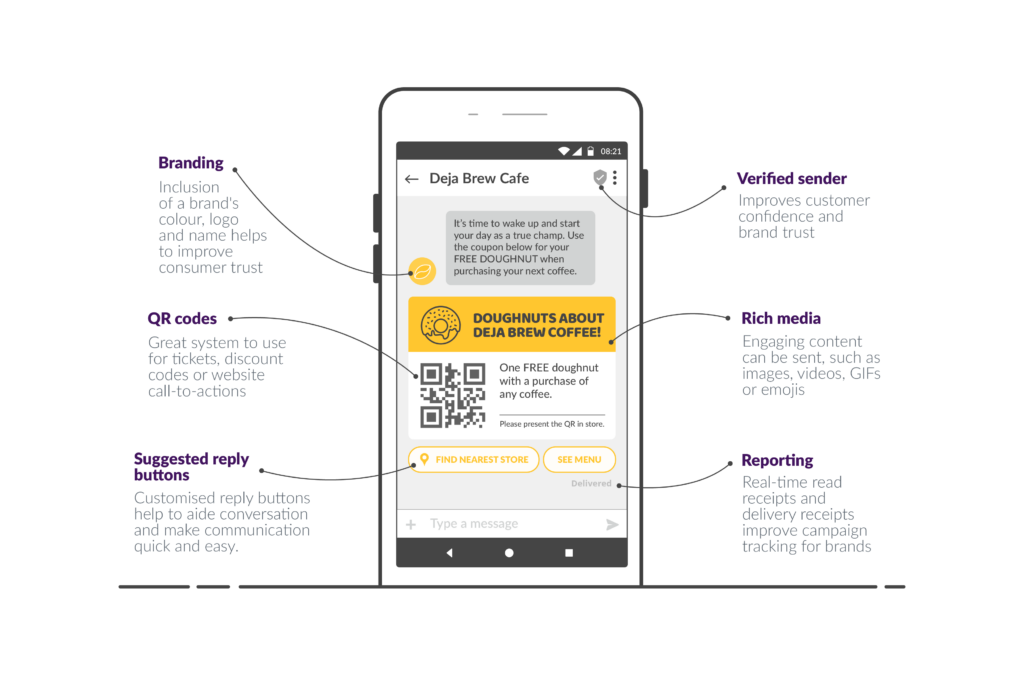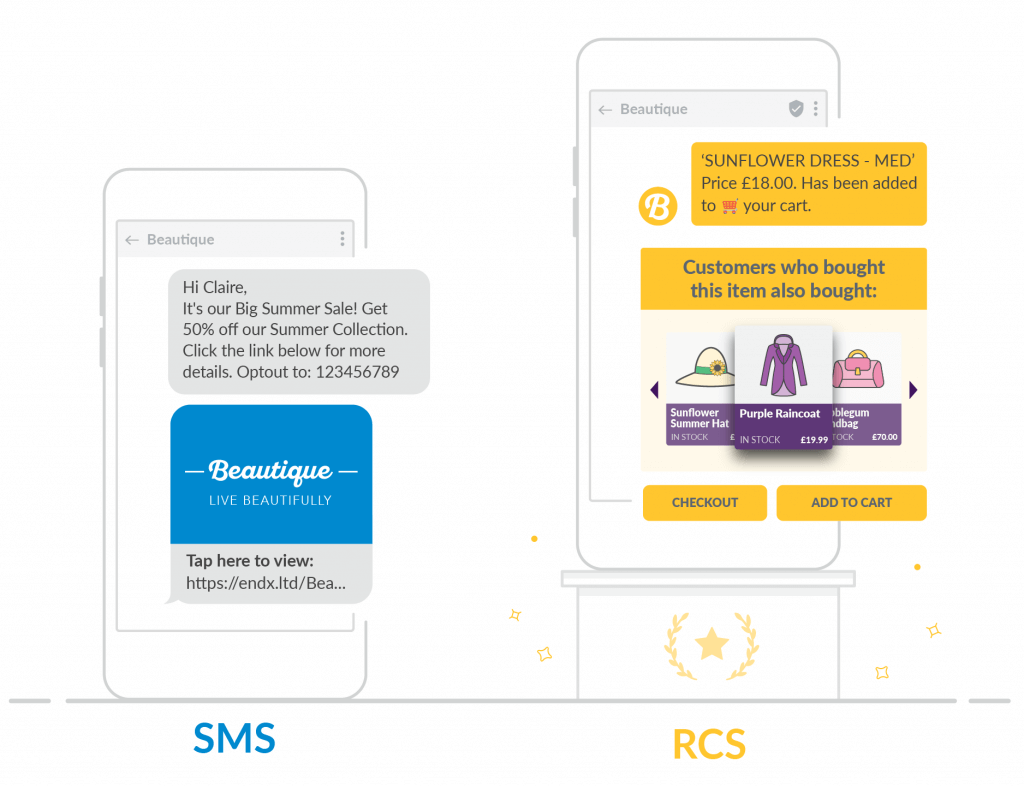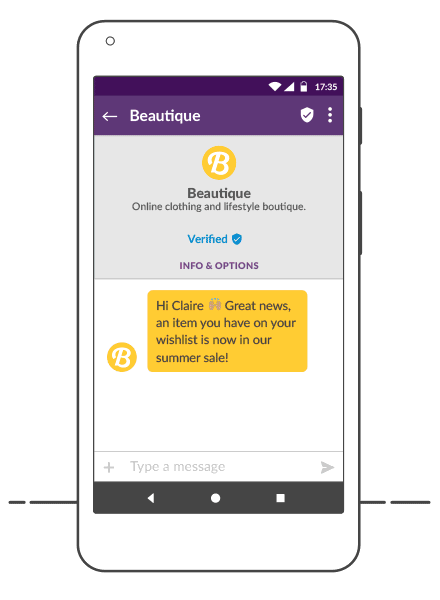
Want to get in front of your customers with engaging, branded and interactive messages? Learn all about how RCS messaging works and why businesses are using it in our complete guide.
SMS has long been a reliable channel for quick, direct communication between people and businesses. However, as users seek more interactive and media-rich experiences, text messaging is evolving. Enter RCS (Rich Communication Services).
RCS is the next step in messaging that brings modern features like high-quality image sharing, interactive elements, and much more directly to your default messaging app.
Below we explore what RCS messaging is, how it works, and why businesses are using this messaging channel to connect with customers.
What is RCS messaging?
RCS, which stands for rich communication services, is like a text message but bigger and bolder – with advanced features like read receipts, multimedia and reply suggestion buttons.
It can look a lot like WhatsApp where customers can receive messages, pictures, video, audio and GIFs. But, unlike WhatsApp, the functionality is already built into mobiles so recipients don’t need to download a separate app.
Whereas SMS messages are sent over a mobile network, RCS messages are sent via Wi-Fi or mobile data.

RCS features include:
- Branded communication
- Interactive content including pictures, videos, GIFs, documents, image carousels, stickers and locations
- Response suggestions and buttons
- Verified business profiles
- QR codes
- Real time reporting (read receipts and delivery receipts)
Who can send and receive RCS messages?
Currently, only Android users are able to send and receive RCS messages. But with Apple confirming that RCS support is coming as part of the iOS 18 release in Autumn 2024, iPhone owners shouldn’t have long to wait.
Adoption of RCS has surged in recent years, with experts predicting that the global market size is valued at $2.29bn in 2024, and is expected to grow by 25.37% from 2024-2029. With Apple coming on board, it’s no doubt going to grow even more with an approximate 1.46bn active iPhone users worldwide.
Tip: If you send a message to a users device which doesn’t support RCS, or they don’t have a WiFi or mobile data connection, your message will automatically be converted and sent as an SMS.
How does RCS compare to SMS?
Both RCS and SMS are excellent tools for reaching customers directly and for sending personalised communications, whether that’s appointment reminders, travel alerts, promotions or event details.
SMS has a 160-character limit, so it’s ideally suited to short communications to drive an action, such as to confirm a booking or appointment, or share an offer code. RCS supports 25,000 characters, so messages can be branded and contain more detail, with supporting rich cards like QR codes, barcodes and e-tickets.
Verified sender is available for SMS to reassure recipients that an organisation is genuine. But again, RCS allows you to go one step further, with company branding, logo and a link to a business profile to maintain a consistent brand identity and instil trust.
With SMS, customers can access links to websites or forms – however RCS gives them a preview in full screen. Multimedia like videos and audio also present information in an easy-to-digest way to encourage a response.
While you may be tempted to choose between RCS and SMS, they are both valuable communication tools and should ideally be used together. If you get the balance right you will also be able to reach a broader audience and connect with customers on more than one channel. Although RCS has more features, SMS has an unbeatable open rate of up to 98% and is extremely reliable.
If you are stuck between the two, we recommend reading our SMS vs RCS guide for an in depth breakdown.

What are the benefits of RCS for businesses?
Improved customer service
Customers can get instant responses to queries with chatbots and automated services, like button replies. They’re able to rearrange appointments from the platform and add events to their calendar in a way that is friction-free, time-saving and convenient.
Increased engagement
Engaging customers with multimedia and rich cards is a great way to showcase your products and services – especially new ones – and create a buzz.
Measurable
It’s easy to monitor performance with read receipts, delivery and seen reports, and analytics that provide valuable insights into your customer interactions. This data can be used to improve your campaigns and communications, and increase your return on investment (ROI).
Peace of mind
Encrypting messages will secure customer data and verified sender ID can help to prevent fraud and spam, while reassuring customers that messages are legitimate. Designing messages to incorporate your branding will improve customer trust too. Esendex has security built into its platform, with an ISO27001 standard and compliance with laws like GDPR.
Save costs
With RCS, brands can reduce overheads because the service enables quick and easy communication with customers to answer queries or provide solutions before they reach complaint level – all while reducing contact centre call volumes.
Easy Integration
With simple documentation, multi-language code samples, and 24/7 expert support, our RCS API makes adding RCS messaging straightforward for any team.
How to use RCS in marketing
Whether you’re a small business or large brand, RCS is a highly effective marketing tool that enables direct communication with customers and an improved user experience. If you already do SMS marketing or have tried it before, RCS could be a great way for you to create even more engaging messages.
Here are a few ways you could use RCS to support your marketing efforts:
Tailored interactions
Research shows that 91% of customers are more likely to shop with brands who recognise and remember them. So, personalise messages by addressing the customer by their first name and offering them products or services based on their buyer behaviour. This data can be extracted through reporting and analytics, which also allows you to segment customers into groups for more precise targeting.
Make it visual
Some 75% of customers rely on product photos when making a purchase, so stand out from competitors by including a high quality image or carousel to display your products. Videos are also great for sharing assembly guides, tutorials or sneak previews for events, and audio is perfect for providing detailed instructions or in-depth answers. GIFs, used in the right way, can also add an element of fun and help you and your brand to seem more approachable.

Make it convenient
Interactive CTA buttons are easy to use and increase the chance of click-throughs to your website or payment page. Reply buttons and signposting to further information will help you to answer customer questions quickly, and improve satisfaction levels.
Customers can also reschedule appointments with RCS and add details to their mobile calendar saving them time that might otherwise be spent in long call queues and reducing the risk of missed appointments.
Boost sales
Boost sales and revenue with high quality pictures and videos that display your products at their best, and send time-limited offers, discount codes and exclusive deals at just the right time. Interactive tools like timers or countdowns can create excitement for an upcoming event or sale.
Improve customer service
Some 90% of customers are likely to buy more from brands with excellent customer service and 72% want an immediate service. RCS enables two-way conversation so you can solve queries or get more information, while chatbots provide instant responses.
Communication across the entire customer journey can be improved with booking or appointment confirmations and reminders, welcome and thank you messages and digital receipts.
Rewards programmes
Improve your rewards programme with RCS by sending automated welcome and thank you messages, birthday gifts, exclusive deals or event invitations that your customers can add to their calendar. Share behind the scenes content to make customers feel like VIPs and let them sign up for loyalty programmes within the app.
Ordering
Increase orders by including pictures, item descriptions, ‘buy now’ buttons, in-stock notifications or trending products. Details of suggested outfits or matching products can also be included to upsell.
Send delivery updates to keep customers informed and support this with pictures when a delivery has been made or is close by.
Instil trust
Use verified sender ID to reassure customers that you are sending from a reputable business and add your branding and logo to create a consistent user experience and improve recognition. If a customer remembers excellent service, they’re more likely to leave a positive review, make a recommendation, and return in the future.
Optimise service
Monitor your performance easily with read receipts, open rates, delivery and seen reports, click-through rates, response and opt-out rates. Use the data received to tailor your communication with customers and optimise and improve your service in the future.
Connect with your customers through RCS
RCS can transform communications, while helping you to convert casual browsers into loyal advocates of your organisation.
Any customer with integrated RCS into their device can receive a rich message. But if a customer doesn’t have an RCS supported device, your message is simply converted into a SMS. With Apple set to introduce it later this year, RCS will soon appeal to a wider audience than ever before.
Whatever sector you work in, RCS is an invaluable tool to share information and support marketing campaigns.
Find out how to use RCS to engage with your audience and grow your business.



